Motorcycle personal protective equipment
To improve motorcycle safety many countries mandate the wearing of personal protective equipment such as protective clothing and helmets. Protective clothing may include certain types of jackets, gloves, boots, and pants. Jackets meant for motorcyclists are typically made of leather or specialized man-made fabrics like cordura or Kevlar. These jackets typically include heavy padding on the elbow, spine, and shoulder regions. Gloves are generally made of leather or Kevlar and some include carbon fiber knuckle protection. Boots, especially those for sport riding, include reinforcement and plastic caps on the ankle and toe areas. Pants are usually leather, cordura, or Kevlar. Except for helmets, none of these items are required by law in any state in the USA, or in any part of the UK but are recommended by many of those who ride.

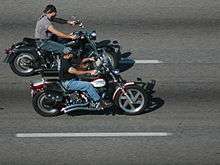
"Off road" riders wear a range of plastic armour to protect against injury from falling off, hitting other riders and bikes, debris kicked up from the rear wheel of leading bikes, and from running into track barriers protecting the public. This armour protects the extremities from breakage and dislocation and the back and chest from strain and broken bones. Although fairly efficient, it is of course not always completely effective. Many riders wear "roost protectors" designed specifically to protect against painful debris from other bikes, but are of no use in a fall or collision.
Clothing
Leathers
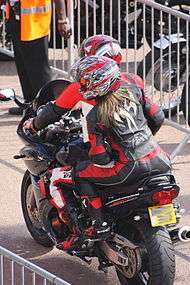
Leathers are one-piece suits or two-piece jackets and trousers worn by motorcyclists, mainly for protection in a crash. In most cases, the type of leather used is not fashion leather but protective leather, which is thicker, stronger, and only moderately flexible. Today, kangaroo leather is becoming popular for its suppleness, light weight, and strength compared to cowhide. Not all leathers used in garments perform equally; products made from full grain, top grain, corrected grain, and suede can have different levels of resistance to abrasion, as well as tearing and bursting forces.
Leather suits were the first motorcyclists' garments to be tested using the Cambridge impact abrasion tester,[1] Some leather products available have been certified as meeting the European Standard EN 13595-1:2002.
Historical development
Originally, motorcycle leathers were adapted from tank corps gear immediately following World War I. Duster coats, which tended to catch in the wheels, were switched for short coats. Wide-pegged breeches were worn by some motorcycle police and by dispatch riders in World War II. The classic American Perfecto motorcycle jacket with epaulets and diagonal zipper, made famous by Marlon Brando in The Wild One, (1954) was invented in 1928 by Irving Schott, of Schott NYC in New York City. Leather chaps, adapted from cowboy gear, were used by American bikers starting in the early 1960s.
The one-piece racing leather suit, usually referred to as 'racing leathers' was first used by world champion motorcycle racer Geoff Duke in the 1950s.[2] Duke had the suit made for the purposes of streamlining, not safety, and like the majority of the leathers used at the time, was made from horsehide.
Armour
Motorcycle garments must have armour on the inside at major impact regions such as shoulders, elbows, hips (with the exception of Class A or B) and knees. Optional protection may be present at the back, chest and lumbar. The European Standards for these protectors are EN 1621-1:2012, EN 1621-2:2014 and EN 1621-3:2018.[3] Motorcycle armor was originally made from high density foam or foam backed hard polymers for impact absorption, and designed to prevent or reduce injury by spreading and dampening impact and shear strains to the wearer. However, viscoelastic materials are increasingly being used because they combine being soft to wear with significant impact absorption. In Europe, by law, armor has to have a CE mark. CE-marked armor comes in two levels, with Level 2 providing greater protection. There are also motorcycle jackets that use an airbag system, which deploys in the event of an accident, inflating to protect the riders neck, torso, and lower back (see also Airbag and Air bag vest). Airbag protection has been used in MotoGP since 2007, and has been compulsory since 2018.
Textiles
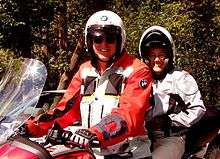
An alternative to leather is clothing constructed of engineered textiles. These can offer improved weather protection from heat, cold, and water, and the increased utility these garments tend to provide in terms of pockets and vents. Common materials include high density (600–1000 Denier) ballistic nylon (e.g., Cordura [4]) and Kevlar, or blends of Kevlar, Cordura, and Lycra; and often include waterproof liners made from materials such as Gore-Tex. In both CE marked (meets European Standards) and non-protective garments, localised protection may be provided by armour[5] and airbag systems.
Not all textile clothing is made from synthetic materials. Denim and heavyweight waxed cotton was used for many years before the development of modern materials.[4]
Boots
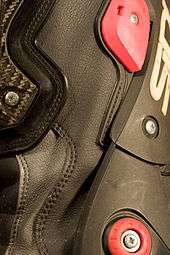
Boots are worn by motorcycle riders and passengers to prevent or reduce harm to their feet and ankles while riding and in the event of a crash. They are designed using materials and seam construction that are impact, abrasion, cut, tear and burst resistant. Tough, strong, moderately flexible boots with stiff soles provide the rider protection from a number of risks. Boots with oil-resistant, rubber-based composite soles give a grip on the pavement and help keep the rider's feet on the pegs. Boots may also have energy absorbers and load spreaders on the shin, inside and outside of each ankle. A stiff sole working laterally helps prevent or decrease crash injuries caused by crushing and shear strain.
There is a European standard available for motorcycle boots, and it is a legal requirement in Europe and the UK for these boots to be CE certified. It tests them for resistance to abrasion, penetration by sharp objects and lateral crushing. The label consists of a motorcycle icon, the designation of the test they've passed and then a series of four numbers. The more '2's on the CE label, the more protective the boot. (1 denotes rudimentary protection, while 2 indicates better protection – in tests of resistance against abrasion, cuts and being crushed.)
Armour
Armour increases the chances of a motorcyclist surviving an accident. The most common form of armour was high-density foam but viscoelsastic material has become more common. It is fitted into the shoulders, elbows, back, hips and knees of motorcycle PPE clothing. Research by Afquir et al (2019) suggested that coccyx protection was crucial but often omitted.[6] Separate protectors are also available, typically for the chest and back, which are worn under other items of clothing.
The most widely cited standard for armor is its CE rating: level 1 (lower protection) or level 2 (better impact absorption). The criteria for levels 1 and 2 vary by intended use – back protection, air bag vest or body armor each have different requirements. The CE standards also classify the surface area that armor protects. For example, body armour is classed as type A (limited coverage) or type B (better coverage). And back protectors are classed as either Centre Back (CB) – which offers no protection to the shoulder blades – or Full Back (FB) coverage.
Research has found limitations with these standards. De Rome et al (2011) found that motorcycle armour was not associated with less risk of fractures.[7] Work by Albanese et al (2017) could explain why: “The allowable transmitted force of EN 1621-1 may be too high to effectively reduce the probability of impact injury.”. [8]
Helmet
A motorcycle helmet is protective headgear used by motorcycle riders. The primary goal of a motorcycle helmet is to protect the rider's head during impact, although many helmets provide additional protection such as a face shield. In many countries the wearing of motorcycle helmets is mandatory.
Helmets are made in two main layers: hard and energy-absorbing. The hard shell spreads an impact over a larger area, while deformation of the liner (often polystyrene foam) absorbs energy so less is transferred to the skull and brain.[9]
There are three main styles: flip-face, open-face and full-face.[10][11] An open-face helmet, which includes half helmets and three-quarter helmets, will protect everything but the face. Full-face helmets protect the skull, plus providing protection for the lower jaw as well as the face itself. Full-face helmets offer much more protection than open-face helmets.[11]
Several manufacturers have introduced full-face helmets with a flip-up front, combining the protection of a full-face with the ease of communication and donning or doffing that an open-face gives.[10]:50
Studies have consistently shown that wearing a helmet:[12][13]
- Reduces injury and increases a rider's chance of surviving a crash
- Does not contribute to neck injuries
- Does not impair vision or hearing
As with other protective gear, a brightly colored helmet improves the user's visibility.[14]
Gloves
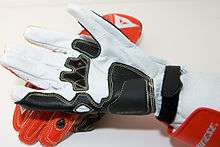
Motorcycling gloves are typically gloves made of leather. They may have gauntlets to protect the rider's wrists from injury, and help reduce drafts while riding in colder climates. Motorcycling gloves typically have reinforced palms intended to protect the rider from abrasion injuries in case of an accident. Under some jurisdictions, if the manufacturer claims the gloves are protective, then they must display CE marking. European Standard EN 13594:2015 is available for this purpose, with gloves certified to Level 1 or Level 2. The latter provides significantly more protection. For example, knuckle protection is not required for a CE Level 1 rating, but is required to achieve Level 2.
Optional features include additional protection or weatherproofing. For touring gloves, such additional features may include advanced insulating materials and waterproof breathable fabric, although touring gloves may still lack advanced armouring features used in motorcycle racing gloves.
Gloves intended for motorcycle racing typically incorporate pre-curved finger sections and the best available protection, obtained through additional armour incorporated within the glove. Additional protection may involve titanium or carbon panels for knuckles and the joints of the fingers. Furthermore, racing gloves may and often do incorporate additional wrist and other protection panels to protect the heel of the hand, back of the hand and other easily injured parts of the hand. Race gloves often have the pinky finger attached to the ring finger to reduce the chance of it being over flexed backwards during crashes.
Goggles
Motorcycle goggles help protect the eyes from dust, wind and debris while riding and typically feature anti-fog treatment and protection against UV rays. For motorcycle sports such as motocross, goggles typically feature a foam rim which seals against the face and layered, tinted lenses to accommodate for varying light conditions.
Testing
Previously, the most recognized method for evaluating protective motorcycle clothing was EN13595-1:2002. This clothing standard was for professional riders and was more suited towards leather garments. The standard offered 2 levels of protection; Lower (level 1) or higher (level 2) protection with an emphasis on impact abrasion resistance, seam burst resistance, tear strength and cut resistance.
The standard specifies the use of the Cambridge type impact abrasion tester. This test involves dropping the clothing material onto an abrasive belt moving at 28 km/hr and measuring the time for a hole to form. This method is often criticized for not being similar to that seen on the road however Dr Woods used both accident damage and that seen in manikins thrown from a moving vehicle to ensure that the test replicated the real world damage as close as possible.This test has been used to show that there is a relationship between fabric thickness and time to hole for protective denim products.
In 2017 a new European Standard began development and EN17092 was created, with the aim of providing satisfactory protection requirements to non professional garments. This immediately allowed the certification of textile garments, without needing the higher ergonomic penalties that the EN13595 standard required. The standard itself follows similar testing methods, with abrasion resistance, tear strength and seam strength key factors that are assessed.
In replacement of the level 1 and level 2 rating system, a new class system was introduced. Class AAA garments provide the highest possible requirements, whilst Class AA and Class A garments each have lower requirements respectively. Two specialist classes are available, Class B garments provide abrasion resistance however do not require impact protection to be present and Class C garments are to be worn as part of an ensemble and have no abrasiom resistant qualities however have a least 1 impact protector present. This class would be used for garments such as base layers.
EN17092 abrasion resistance is carried out on a Darmstadt impact abrasion machine rather than the previous Cambridge abrasion machine. The Darmstadt was developed at a similar time but was not adopted by European Committee for Standardization. It involves dropping the test specimen onto a block of concrete and assessing whether the layer that would be closest to the skin forms a hole of 5mm or more. The specimen is held on the outer edge of a rotating arm and is travelling at speeds of up to 707rpm when it hits the surface. As the specimen holder is no longer driven, once dropped, the sample will slide on the concrete surface until it stops due to surface friction between it and the concrete surface. Unlike the Cambridge machine, a slide time in seconds is not given therefore no direct comparison is readily available.
EN17092 was published in March 2020 with EN13595 to be withdrawn by the latest of March 2023. The Cambridge abrasion and impact cut test methods will remain present for EN13594 glove and EN13634 motorcycle boot testing. Also, the Cambridge impact abrasion test is used by the Motorcycle Clothing Assessment Program (MotoCAP) in Australia and New Zealand.[15]
A consortium of government and related organisations across Australia and New Zealand established MotoCAP. Its safety ratings assess how well clothing protects a motorcyclist in a crash (based on impact protection, burst resistance and abrasion resistance). Test results are weighted to emphasise the need for greater security in high-risk areas. Additionally, MotoCAP test results give a breathability score based on the Relative Vapour Permeability Index.
References
- Woods, R. I. 1996 Belt abrader impact abrasion testing of leathers and fabrics used in motorcycle riders' clothing. In Performance of Protective Clothing Fifth Volume, pp. 57-69
- Walker, Mick (2007). Geoff Duke: The Stylish Champion. MBI Publishing Company. p. 53. ISBN 9781859835456.
- Smith, Jerry (May 16, 2013). "CE or Not CE? The Hard Truth About Armor What to look for: Armor in the shoulders, elbows and knees will protect you, but not just any armor". Motorcyclist.
- Bill Wood (June 2003), "Cordura commando: how a small company in Duluth changed the motorcycle world", American Motorcyclist, pp. 49–52
- Jerry Smith (July 1, 2013), "The Hard Truth About Armor: CE or not CE?", Motorcyclist, retrieved 2013-11-12
- A systematic review on the effectiveness of back protectors for motorcyclists. Ekmejian R, Sarrami P, Naylor JM, Harris IA. Scand J Trauma Resusc Emerg Med. 2016 Oct 4;24(1):115. doi: 10.1186/s13049-016-0307-3.
- Liz de Rome et al. Motorcycle protective clothing: Protection from injury or just the weather? Accident Analysis & Prevention. Volume 43, Issue 6, November 2011, Pages 1893-1900.
- Bianca Albanese et al. Energy Attenuation Performance of Impact Protection Worn by Motorcyclists in Real-World Crashes. Traffic Inj Prev. 2017 May 29;18(sup1):S116-S121. doi: 0.1080/15389588.2017.1311014.
- Andrew Mellor, Advanced Motorcycle Helmets (PDF), NHTSA, retrieved 2012-10-06,
A helmet is designed to protect the rider in the event of an accident by absorbing impact energy and reducing the loading imparted to the head via the helmet.
- Coyner, Dale (2017). The Essential Guide to Motorcycle Travel, 2nd Edition: Planning, Outfitting, and Accessorizing. Essential Guide Series. Motorbooks. pp. 48–50. ISBN 978-0-7603-5270-0. Retrieved 2020-03-23.CS1 maint: ref=harv (link)
- Davis, James R.; Anthony, Cash (2011), Motorcycle Safety and Dynamics: Vol 1, Houston, Texas: Master Strategy Group, ISBN 1257645889
- "Helmets for preventing injury in motorcycle riders". Center for Advancing Health. 2008-01-23.
- "Q&As: Motorcycle helmet use laws". Insurance Institute for Highway Safety.
- Susan Wells; et al. (2004-04-10). "Motorcycle rider conspicuity and crash related injury: case-control study". BMJ. Retrieved 2007-09-02. Abstract, Quick summary
- https://motocap.com.au/
External links
| Wikimedia Commons has media related to Motorcycle protective clothing. |
- Motorcycle Protective Clothing on Motorcycle Council of New South Wales website